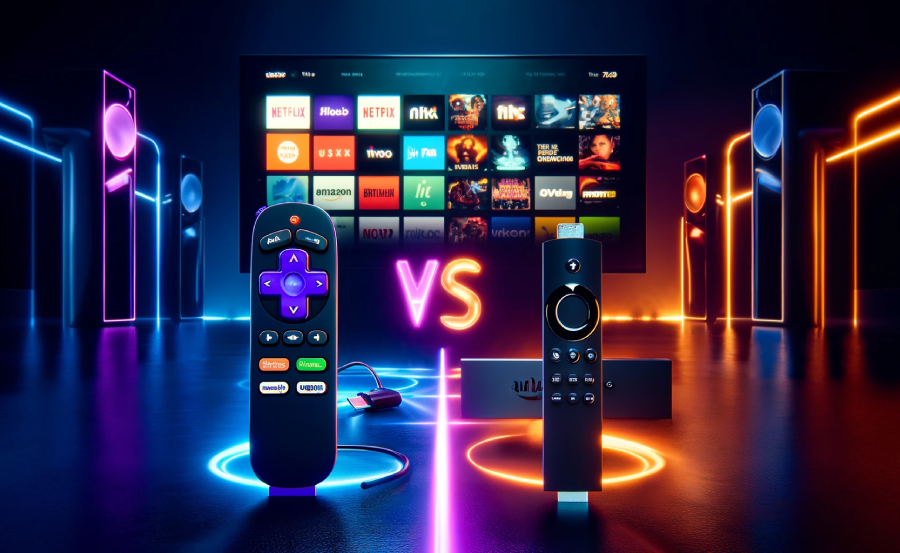In the current era of digital streaming, choosing the correct media device for your television can feel overwhelming. With countless options on the market, two popular choices often stand out: Roku and Amazon’s Fire Stick. This decision can significantly affect your streaming quality, available apps, and overall user experience. Oh, and let’s not forget about the rise of high-quality streaming services like Rapid IPTV, which promises to redefine your viewing experience.
Understanding Roku and Fire Stick: The Basics
Roku: Simplicity and a Vast Selection
Roku has become synonymous with user-friendly streaming. Its interface is designed to be intuitive, often described as plug-and-play. The broad range of channels means there’s something for everyone. From free channels to premium subscriptions, Roku offers flexibility. Its open platform is a favored feature, allowing easy addition of channels without intricate setups. Simply put, it is an accessible device that doesn’t demand technical expertise from its users.
Moreover, Roku maintains a focus on content rather than tech specs. With an expansive channel store, Roku supports a variety of streaming services, including Netflix, Hulu, and Disney+, to name a few. More often than not, it becomes a favorite for those who appreciate a hassle-free setup and navigation. But, can it compete with the Fire Stick’s capabilities?
Pro Tip:
Stream a year of non-stop entertainment with 1 Year IPTV Subscription from Best IPTV Provider, offering a wide range of channels and on-demand content.
Fire Stick: Alexa-Enabled and Feature-Rich
Amazon’s Fire Stick brings a lot to the table, but one of its standout features is the integration with Alexa. Voice control elevates user interaction to another level, allowing for hands-free browsing. Fire Stick’s interface gives an impression of luxury with its rich display and detailed content suggestions, often tailored to the individual’s preferences.
While the Fire Stick might require a little more adjustment with its interfaces and endless updates, it promises an enhanced personalized experience. Its ability to sync with Amazon Prime offerings is a significant advantage, catering well to those within the Amazon ecosystem. Is this synchronization across devices enough to sway users towards the Fire Stick?
Installation and Setup: A User’s Perspective
Ease of Installation: Plug and Play?
- Roku: Typically requires basic steps – connect to HDMI, power up, and you’re halfway there. Its simple interface means configuration takes minutes, ensuring users watch content almost instantly.
- Fire Stick: Similar process, slightly influenced by Amazon account linkage. Initial login requires a stable connection and account verification, making it straightforward for Amazon users but also a bit of an effort for others.
Setting Preferences: User Experience at Its Core
Customization is an essential part of the streaming experience. Both Roku and Fire Stick offer diverse options, from selecting preferred languages to personalized watchlists. Roku’s remote might appear more conventional, but it compensates with a practical layout. On the other hand, Fire Stick’s voice-enabled remote sets it apart, promoting convenience, especially for those accustomed to using voice commands in their daily activities.
The ease of use in setup might seem trivial, but it is crucial when considering technical skill levels. This factor could influence whether a family gravitates towards Roku’s simplicity or Fire Stick’s depth.
Content Availability: What’s on Offer?
Roku’s Expansive Library
Roku is often celebrated for its content diversity. With access to thousands of channels, sometimes exclusive to Roku, users are spoiled for choice. There’s everything from mainstream favorites to niche networks, catering to a wide audience. This broad coverage is a strong suit of Roku, making it a very appealing option for those seeking variety beyond conventional streaming services.
Roku’s philosophy is centered on content convenience, providing effortless access to numerous subscription services. But, does it stand up when compared to the likes of Fire Stick and its Amazon-centric offerings?
Fire Stick’s Targeted Approach
Amazon Fire Stick tends to focus more on integrating its own services, heavily promoting Amazon Prime Video content. However, this doesn’t limit its usage. It supports a wide range of apps similar to Roku, though tightly knit within the Amazon ecosystem. This might attract users who are already embedded in Amazon’s product suite.
If streaming quality is paramount, Fire Stick boasts HD and 4K options, provided you have a suitable TV. These high-definition audiovisual experiences are often a deciding factor, particularly for enthusiasts seeking more vivid, immersive content.
Performance and Technical Specifications
Comparing Processing Power
In terms of raw power, Fire Stick often has the edge. Equipped with a robust processor, it supports rapid app loading and smoother navigation. This technical edge could potentially translate to a more seamless viewing experience, although Roku’s efficient operation shouldn’t be understated as it maintains solid performance despite slightly less processing capability.
Is more horsepower necessary for everyday streaming, or can Roku’s reliability suffice for the average viewer? This depends greatly on the user’s consumption habits and how they interact with their device.
Video Quality Capabilities
For those who demand premium viewing quality, the Fire Stick’s support for 4K streaming is an enticing option. Pair it with a compatible television, and the visuals become significantly crisper. Roku offers 4K versions too, notably the Roku Ultra, ensuring it doesn’t fall too far behind.
For those interested in maximizing HD performance, a Rapid IPTV HD subscription can complement either device. Pairing these services offers users an optimal blend of device capability and streaming excellence.
Additional Features Enhancing Experience
Smart Assistants and Integration
Fire Stick’s integration with Alexa is a highlight for many users. Delivering commands for content changes or checking weather forecasts can be done seamlessly. This aspect is less pronounced in Roku’s ecosystem, though newer models may offer basic voice search capabilities.
Both devices can integrate with smart home systems to varying degrees. For someone already embedded within a specific tech environment, the device choice might boil down to which assistant or smart hub is utilized more consistently in their household.
Interface Customization and Personal Touch
The extent to which you can alter the look and feel of your streaming device interface might not top every user’s priority list, but it can contribute to the enjoyment of using the device. Roku provides simple tweaks, keeping things straightforward, whereas Fire Stick offers more in-depth customization, aligning with other Amazon services.
These options make each device feel unique to the user, but whether customization needs outweigh ease of use is subjective and varies by individual preference.
Introducing Rapid IPTV: Seamless Streaming Superiority
What is Rapid IPTV?
In the world of streaming, Rapid IPTV stands out as a premier service provider. Known for its vast library and high-definition subscriptions, Rapid IPTV serves as a comprehensive solution for media enthusiasts. Its offering transcends traditional live TV, bringing a combination of entertainment channels, sports, and international viewing options straight to your screen.
Users often tout the stability and consistency of Rapid IPTV, especially those seeking a reliable service for global content. It’s a perfect match for advanced devices like Roku and Fire Stick, providing an impeccable streaming encounter.
Why Choose Rapid IPTV?
There are numerous IPTV services out there, but Rapid IPTV prides itself on unparalleled performance and user satisfaction. Whether you’re keen on sports channels or international content, Rapid IPTV’s wide selection and quality assurance make it a leader in IPTV solutions. Its seamless integration with popular streaming devices elevates the user experience, creating a synergy between state-of-the-art technology and superior content delivery.
- High-definition streaming capabilities.
- Reliable across different bandwidths.
- Supports a wide range of devices, including Roku and Fire Stick.
- Exceptional customer support and service uptime.
Making the Final Decision: What’s Right for You?
Selecting between Roku and Fire Stick ultimately comes down to personal preference and individual use cases. If ease of use and a broad content selection are priorities, Roku emerges as a straightforward choice. However, those seeking integration with smart home features and higher customization might lean towards the Fire Stick, especially if they are already immersed in the Amazon ecosystem.
In either case, complementing these devices with a superior service like Rapid IPTV assures users of a top-tier viewing encounter. As technological boundaries continue to blur, having a reliable IPTV subscription, such as Rapid IPTV, enhances both devices’ functionality, turning any TV into an all-encompassing entertainment portal.
Frequently Asked Questions

What are the main advantages of using a Roku over a Fire Stick?
Roku excels in simplicity and a user-friendly interface. Its vast content library is accessible to all without needing extensive configuration. Ideal for those who prioritize ease of use and channel diversity over additional features.
Is Alexa integration a significant benefit for Fire Stick users?
Indeed, Alexa integration presents convenience for many users, especially those already using Alexa-compatible devices. It allows for hands-free operation, voice searches, and integration with other smart home gadgets.
Can Rapid IPTV be used on both Roku and Fire Stick?
Yes, Rapid IPTV is designed to work seamlessly across both devices, providing high-definition streaming capabilities. Its compatibility makes it an excellent addition to either device, enriching the user experience.
How do Rapid IPTV subscriptions enhance the streaming experience?
Rapid IPTV offers not only a wide array of channels but also consistent reliability and stream quality. With HD IPTV subscriptions, users experience improved clarity, which complements the capabilities of the streaming devices.
Which device offers better video quality out of the box?
Both Roku and Fire Stick offer devices capable of 4K video streaming. However, Fire Stick’s emphasis on Amazon Prime Video’s extensive 4K content provides an edge for those specifically focused on high-definition streaming.
What should I consider when deciding between Roku and Fire Stick?
Consider your ecosystem compatibility, preferred interface, and the specific features you need. Whether it’s seamless smart assistant integration with Fire Stick or the straightforward, content-rich Roku interface, both devices offer robust options. Pairing with Rapid IPTV can enhance your streaming encounter, regardless of choice.
Exploring Amazon Firestick’s Parental Control Features
